Big Data Analytics in Australian Local Government
Abstract
:1. Introduction
2. Local Government Big Data Projects in Other Countries
3. Australian Government Open Data
4. Analysis of Big Data by Machine Learning
4.1. Data Analytics with Python Libraries
- download the relevant datasets (in this case, from the relevant portal)
- read the dataset and check what data types it contains
- refine the data by replacing coded values and NaN (not a number) values with appropriate numeric values
- use the matplotlib and seaborn libraries to perform visualization of the data (such as shown in Figure 4 below)
- explore dependencies of target outcome (such as accident severity) on relevant features such as road type, lighting, speed zone
4.2. Predictive Machine Learning with Python Libraries
- predict outcomes using Naïve Bayes, Linear Support Vector Classification, K Neighbors Classifier, Random Forest, or other models
- compare model accuracy which can then inform the appropriate ML model
- save the model using the joblib library
- create an API using the flask framework
- test the model over the web using the Postman® client.
- Input:
- {“LIGHT_CONDITION”:5, “SPEED_ZONE”:110, “ROAD_GEOMETRY”:5},
- {“LIGHT_CONDITION”:9, “SPEED_ZONE”:30, “ROAD_GEOMETRY”:9}
- Output:
- {“prediction”: “[2, 3]”}
5. Big Data Projects Sponsored by the Authors
- Analysis of pedestrian traffic in the COM (Swinburne University)
- Victorian local government open datasets web APIs (Swinburne University)
- Development of web APIs to assist local government manage waste disposal and recycling (being done by one of the authors and Monash University)
- Analysis of COM social indicator survey (currently being done only by one of the authors)
5.1. City of Melbourne Pedestrian Traffic Analysis
5.2. Victorian Local Government Web API Project
5.3. Waste Management Web API Project
5.4. Analysis of City of Melbourne Social Indicator Survey and Livability Datasets
- Participate in adequate physical activity
- Participate in sports and exercise activities
- Participate in sports and exercise activities in COM
- Participate in organized physical activity
- Participate in physical activity organized by a fitness, leisure, or indoor sports center
- Participate in physical activity organized by a sports club or association
6. Conclusions
Author Contributions
Funding
Acknowledgments
Conflicts of Interest
References
- City of Adelaide. Ten Gigabit Adelaide. 2018. Available online: https://www.cityofadelaide.com.au/business/ten-gigabit-adelaide/ (accessed on 28 May 2020).
- Australian Government. Find, Explore and Reuse Australia’s Public Data. 2020. Available online: https://data.gov.au/ (accessed on 5 April 2020).
- Criterion Conferences. How Data Analytics can Improve Local Government. 2016. Available online: https://www.criterionconferences.com/blog/government/data-analytics-can-improve-local-government/ (accessed on 5 April 2020).
- Kitchin, R.; McArdle, G. What makes Big Data, Big Data? Exploring the ontological characteristics of 26 datasets. Big Data Soc. 2016, 3, 1–10. [Google Scholar] [CrossRef]
- Günther, W.A.; Mehrizi, M.H.R.; Huysman, M.; Feldberg, F. Debating big data: A literature review on realizing value from big data. J. Strat. Inf. Syst. 2017, 26, 191–209. [Google Scholar] [CrossRef]
- Lim, C.; Kim, K.-J.; Maglio, P.P. Smart cities with big data: Reference models, challenges, and considerations. Cities 2018, 82, 86–99. [Google Scholar] [CrossRef]
- Albino, V.; Berardi, U.; Dangelico, R.M. Smart Cities: Definitions, Dimensions, Performance, and Initiatives. J. Urban Technol. 2015, 22, 3–21. [Google Scholar] [CrossRef]
- Sodiq, A.; Baloch, A.A.; Khan, S.A.; Sezer, N.; Mahmoud, S.; Jama, M.; Abdelaal, A. Towards modern sustainable cities: Review of sustainability principles and trends. J. Clean. Prod. 2019, 227, 972–1001. [Google Scholar] [CrossRef]
- Bibri, S.E. The IoT for smart sustainable cities of the future: An analytical framework for sensor-based big data applications for environmental sustainability. Sustain. Cities Soc. 2018, 38, 230–253. [Google Scholar] [CrossRef]
- Silva, B.N.; Khan, M.; Han, K. Towards sustainable smart cities: A review of trends, architectures, components, and open challenges in smart cities. Sustain. Cities Soc. 2018, 38, 697–713. [Google Scholar] [CrossRef]
- Huovila, A.; Bosch, P.; Airaksinen, M. Comparative analysis of standardized indicators for Smart sustainable cities: What indicators and standards to use and when? Cities 2019, 89, 141–153. [Google Scholar] [CrossRef]
- Glaeser, E.L.; Kominers, S.D.; Luca, M.; Naik, N. Big data and big cities: The promises and limitations of improved measures of urban life. Econ. Inquir. 2018, 56, 114–137. [Google Scholar] [CrossRef]
- Silva, B.N.; Khan, M.; Jung, C.; Seo, J.; Diyan, M.; Han, J.; Yoon, Y.; Han, K. Urban Planning and Smart City Decision Management Empowered by Real-Time Data Processing Using Big Data Analytics. Sensors 2018, 18, 2994. [Google Scholar] [CrossRef] [Green Version]
- Munné, R. Big Data in the Public Sector. In New Horizons for a Data-Driven Economy; Cavanillas, J.-M., Curry, E., Wahlster, W., Eds.; Springer Science and Business Media LLC: Berlin, Germany, 2016; pp. 195–208. [Google Scholar]
- Bright, J.; Ganesh, B.; Seidelin, C.; Vogl, T.M. Data Science for Local Government. SSRN Electron. J. 2019. [Google Scholar] [CrossRef] [Green Version]
- Oates, J. Big Data and Local Government. 2018. Available online: https://www.cbronline.com/opinion/big-data-local-government (accessed on 8 April 2020).
- de Souza, J.T.; de Francisco, A.C.; Piekarski, C.M.; Prado, G.F. Data mining and machine learning to promote smart cities: A systematic review from 2000 to 2018. Sustainability 2019, 11, 1077. [Google Scholar] [CrossRef] [Green Version]
- Sutcliffe, D. What are the Barriers to Big Data Analytics in Local Government? 2017. Available online: https://blogs.oii.ox.ac.uk/policy/what-are-the-barriers-to-big-data-analytics-in-local-government/ (accessed on 5 April 2020).
- Malomo, F.; Sena, V. Data Intelligence for Local Government? Assessing the Benefits and Barriers to Use of Big Data in the Public Sector. Policy Internet 2016, 9, 7–27. [Google Scholar] [CrossRef]
- Symons, T. Datavores of Local Government: Using Data to Make Services More Personalised, Effective and Efficient. 2016. Available online: https://media.nesta.org.uk/documents/local_datavores_discussion_paper-july-2016.pdf (accessed on 16 January 2020).
- Zanmiller, A. The State of Open Data in American Local Governments. Digital Commons @ Cal Poly, California Polytechnic State University—San Luis Obispo, US. 2015. Available online: https://digitalcommons.calpoly.edu/crpsp/128/ (accessed on 2 June 2020).
- Kim, G.-H.; Trimi, S.; Chung, J.-H. Big-data applications in the government sector. Commun. ACM 2014, 57, 78–85. [Google Scholar] [CrossRef]
- Hong, S.; Kim, S.H.; Kim, Y.; Park, J. Big Data and government: Evidence of the role of Big Data for smart cities. Big Data Soc. 2019, 6, 1–11. [Google Scholar] [CrossRef]
- Open Knowledge Australia. Who is Publishing Open Data in Australia. 2016. Available online: https://opencouncildata.org/australia/ (accessed on 10 April 2020).
- Australian Government. Australian Government Public Data Policy Statement. 2015. Available online: https://www.pmc.gov.au/sites/default/files/publications/aust_govt_public_data_policy_statement_1.pdf (accessed on 8 June 2020).
- The World Bank. Open Data Toolkit Technology Option. 2019. Available online: http://opendatatoolkit.worldbank.org/en/technology.html (accessed on 10 April 2020).
- Carter, E.; Adam, P.; Tsakis, D.; Shaw, S.; Watson, R.; Ryan, P. Enhancing pedestrian mobility in Smart Cities using Big Data. J. Manag. Anal. 2020, 7, 173–188. [Google Scholar] [CrossRef]
- Nelli, F. Python Data Analytics; Springer Science and Business Media LLC: Berlin, Germany, 2018. [Google Scholar]
- Cross, B. Comparing Machine Learning as a Service: Amazon, Microsoft Azure, Google Cloud AI, IBM Watson. 2018. Available online: https://www.altexsoft.com/blog/datascience/comparing-machine-learning-as-a-service-amazon-microsoft-azure-google-cloud-ai-ibm-watson/ (accessed on 7 April 2020).
- DataRobot. Enabling the AI-Driven Enterprise. 2020. Available online: https://datarobot.com (accessed on 1 May 2020).
- Rstudio. Open Source & Professional Software for Data Science Teams. 2020. Available online: https://rstudio.com (accessed on 16 January 2020).
- BigML. Machine Learning Made Beautifully Simple for Everyone. 2020. Available online: https://bigml.com/ (accessed on 16 January 2020).
- Altexsoft. Machine Learning Project Structure: Stages, Roles, and Tools. 2018. Available online: https://www.altexsoft.com/blog/datascience/machine-learning-project-structure-stages-roles-and-tools/ (accessed on 7 April 2020).
- Brownlee, J. How to Make Predictions with Scikit-learn. 2018. Available online: https://machinelearningmastery.com/make-predictions-scikit-learn/ (accessed on 5 April 2020).
- Watson, R.; Ryan, P. Visualization and Prediction of Road Accident Data Using Python Machine Learning Version 2. (Unpublished work). 2020; (Watson, R. unaffiliated; Ryan, P. Defence Science & Technology Group). [Google Scholar]
- Brownlee, J. How to Connect Model Input Data With Predictions for Machine Learning. 2019. Available online: https://machinelearningmastery.com/how-to-connect-model-input-data-with-predictions-for-machine-learning/ (accessed on 5 April 2020).
- Paul, S. Turning Machine Learning Models into APIs in Python. 2018. Available online: https://www.datacamp.com/community/tutorials/machine-learning-models-api-python (accessed on 18 January 2020).
- Berlind, D. What Are APIs and How Do They Work? 2015. Available online: https://www.programmableweb.com/api-university/what-are-apis-and-how-do-they-work (accessed on 16 January 2020).
- IBM. Overview: Watson Machine Learning. 2020. Available online: https://dataplatform.cloud.ibm.com/docs/content/wsj/analyze-data/ml-overview.html (accessed on 13 January 2020).
- Medvedev, A.; Fedchenkov, P.; Zaslavsky, A.; Anagnostopoulos, T.; Khoruzhnikov, S. Waste Management as an IoT-Enabled Service in Smart Cities. In Intelligent Tutoring Systems; Springer Science and Business Media LLC: Berlin, Germany, 2015; Volume 9247, pp. 104–115. [Google Scholar]
- Anagnostopoulos, T.; Zaslavsky, A.; Kolomvatsos, K.; Medvedev, A.; Amirian, P.; Morley, J.; Hadjieftymiades, S. Challenges and Opportunities of Waste Management in IoT-Enabled Smart Cities: A Survey. IEEE Trans. Sustain. Comput. 2017, 2, 275–289. [Google Scholar] [CrossRef]
- Esmaeilian, B.; Wang, B.; Lewis, K.; Duarte, F.; Ratti, C.; Behdad, S. The future of waste management in smart and sustainable cities: A review and concept paper. Waste Manag. 2018, 81, 177–195. [Google Scholar] [CrossRef]
- Sharma, M.; Joshi, S.; Kannan, D.; Govindan, K.; Singh, R.; Purohit, H. Internet of Things (IoT) adoption barriers of smart cities’ waste management: An Indian context. J. Clean. Prod. 2020, 270, 122047. [Google Scholar] [CrossRef]
- Gupta, P.K.; Shree, V.; Hiremath, L.; Rajendran, S. The Use of Modern Technology in Smart Waste Management and Recycling: Artificial Intelligence and Machine Learning. In Advances in Intelligent Information and Database Systems; Springer Science and Business Media LLC: Berlin, Germany, 2019; Volume 823, pp. 173–188. [Google Scholar]
- Pardini, K.; Rodrigues, J.J.P.C.; Kozlov, S.; Kumar, N.; Furtado, V. IoT-Based Solid Waste Management Solutions: A Survey. J. Sens. Actuator Netw. 2019, 8, 5. [Google Scholar] [CrossRef] [Green Version]
- Rutqvist, D.; Kleyko, D.; Blomstedt, F. An Automated Machine Learning Approach for Smart Waste Management Systems. IEEE Trans. Ind. Inf. 2020, 16, 384–392. [Google Scholar] [CrossRef]
- Al-Masri, E.; Diabate, I.; Jain, R.; Lam, M.H.; Nathala, S.R. Recycle.io: An IoT-Enabled Framework for Urban Waste Management. In Proceedings of the 2018 IEEE International Conference on Big Data (Big Data), Seattle, WA, USA, 10–13 December 2018; pp. 5285–5287. [Google Scholar]
- Idwan, S.; Mahmood, I.; Zubairi, J.A.; Matar, I. Optimal Management of Solid Waste in Smart Cities using Internet of Things. Wirel. Pers. Commun. 2019, 110, 1–17. [Google Scholar] [CrossRef]
- Chaudhari, S.S.; Bhole, V.Y. Solid Waste Collection as a Service using IoT-Solution for Smart Cities. In Proceedings of the 2018 International Conference on Smart City and Emerging Technology (ICSCET), Mumbai, India, 5 January 2018; pp. 1–5. [Google Scholar]
- Fataniya, B.; Sood, A.; Poddar, D.; Shah, D. Implementation of IoT based Waste Segregation and Collection System. Int. J. Electron. Telecommun. 2019, 65, 579–584. [Google Scholar]
- Bristol City Council. Towards a Zero Waste Bristol: Waste and Resource Management Strategy. 2016. Available online: https://www.bristol.gov.uk/documents/20182/33395/Towards+a+Zero+Waste+Bristol+-+Waste+and+Resource+Management+Strategy/102e90cb-f503-48c2-9c54-689683df6903 (accessed on 2 May 2020).
- MacDonald, L. Smart Bins Detecting Smelly Rubbish and Wi-Fi Benches, All Part of Hobart’s Hi-Tech Future. 2018. Available online: https://www.abc.net.au/news/2018-09-13/smart-bins-in-hobart-will-let-you-know-when-full/10238770]. (accessed on 26 April 2020).
- Waste Management Review. Councils Benefit from Solar Bins Australia. 2018. Available online: https://wastemanagementreview.com.au/smart-bins/ (accessed on 27 April 2020).
- Wyndham City Council. Benchmarking Wyndham as a Smart City. 2019. Available online: https://www.wyndham.vic.gov.au/sites/default/files/2019-03/Benchmarking%20Wyndham%20as%20a%20Smart%20City.pdf (accessed on 16 January 2020).
- Docker. What is a Container? A standardized Unit of Software. 2020. Available online: https://www.docker.com/resources/what-container (accessed on 3 June 2020).
- Buskirk, T.D.; Kirchner, A.; Eck, A.; Signorino, C.S. An Introduction to Machine Learning Methods for Survey Researchers. Surv. Pr. 2018, 11, 1–10. [Google Scholar] [CrossRef] [Green Version]
- Ramirez, C.M.; Abrajano, M.A.; Alvarez, R.M. Using Machine Learning to Uncover Hidden Heterogeneities in Survey Data. Sci. Rep. 2019, 9, 16061. [Google Scholar] [CrossRef] [Green Version]
- Kim, S.-Y.S.; Alvarez, R.M.; Ramirez, C.M. Who Voted in 2016? Using Fuzzy Forests to Understand Voter Turnout. Soc. Sci. Q. 2020, 101, 978–988. [Google Scholar] [CrossRef] [Green Version]
- City of Melbourne. Social Indicators for City of Melbourne Residents. 2018. Available online: https://data.melbourne.vic.gov.au/People/Social-Indicators-for-City-of-Melbourne-Residents-/n9ie-cp6t (accessed on 1 April 2020).
- City of Melbourne. City of Melbourne Liveability and Social Indicators. 2019. Available online: https://data.melbourne.vic.gov.au/People/City-of-Melbourne-Liveability-and-Social-Indicator/nyr3-sees (accessed on 3 April 2020).
- City of Melbourne. Indicators of Wellbeing by Year (Future Melbourne). 2020. Available online: https://data.melbourne.vic.gov.au/People/Indicators-of-wellbeing-by-year-Future-Melbourne-/khvg-gtaq (accessed on 6 April 2020).
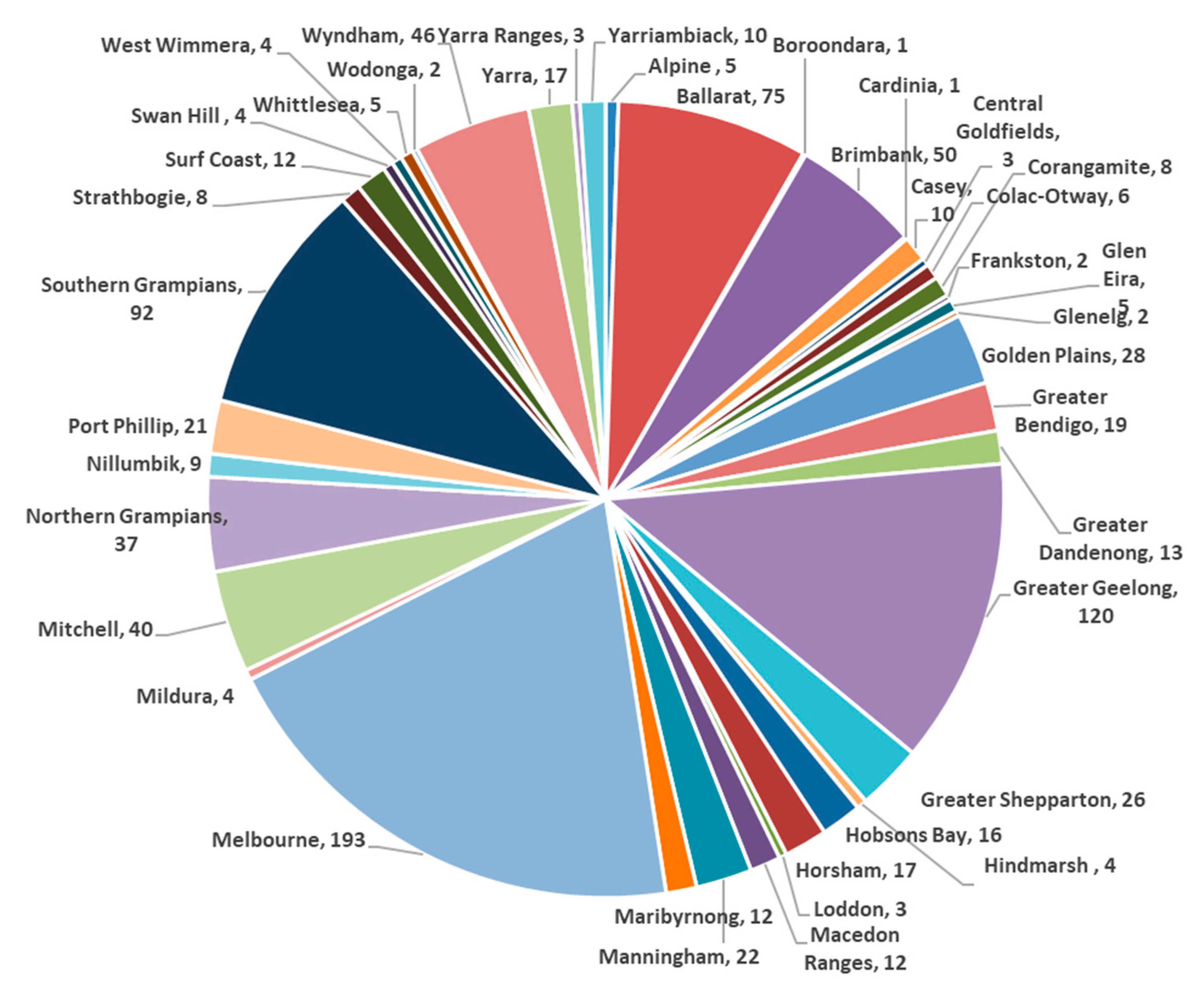

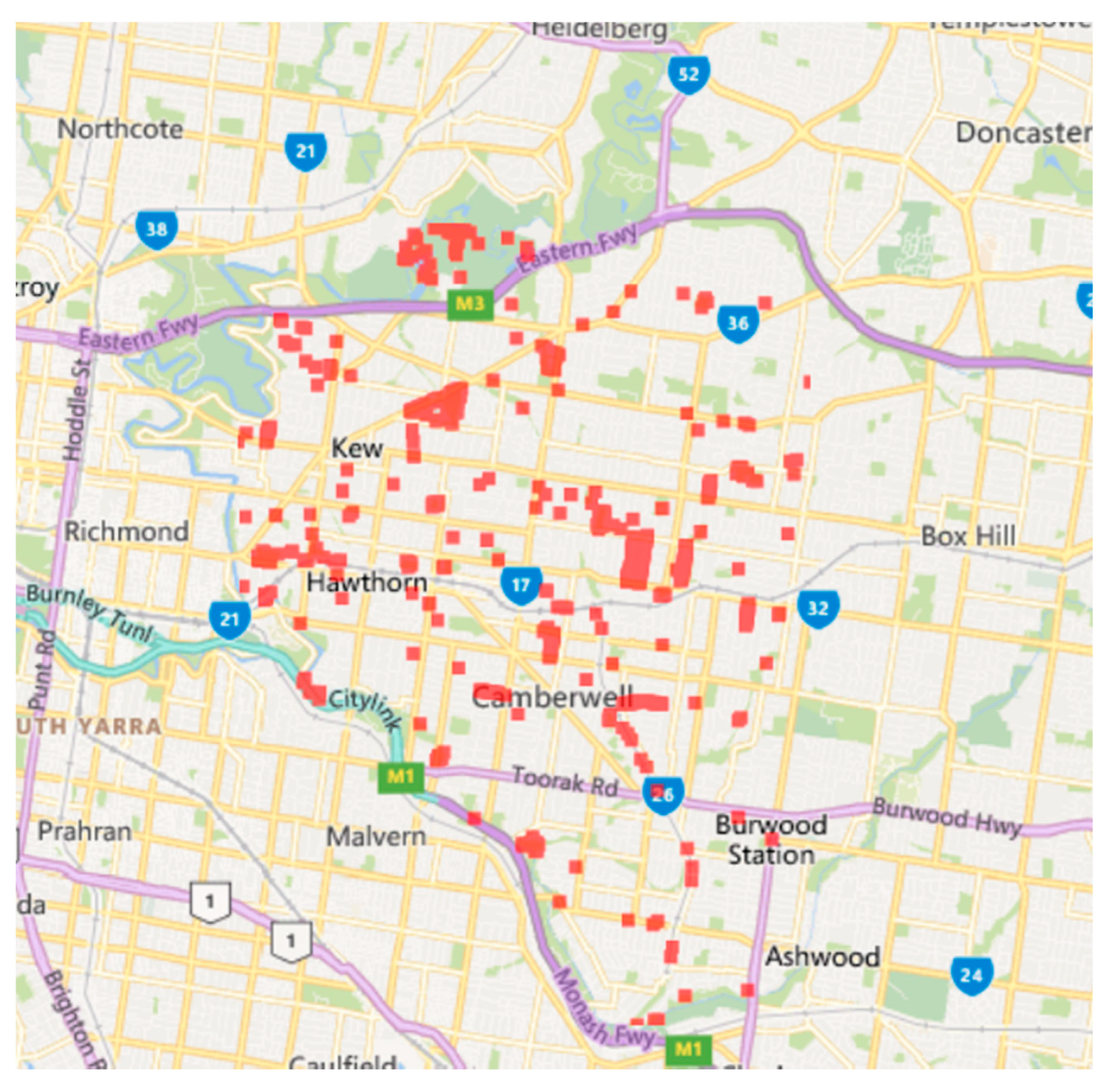
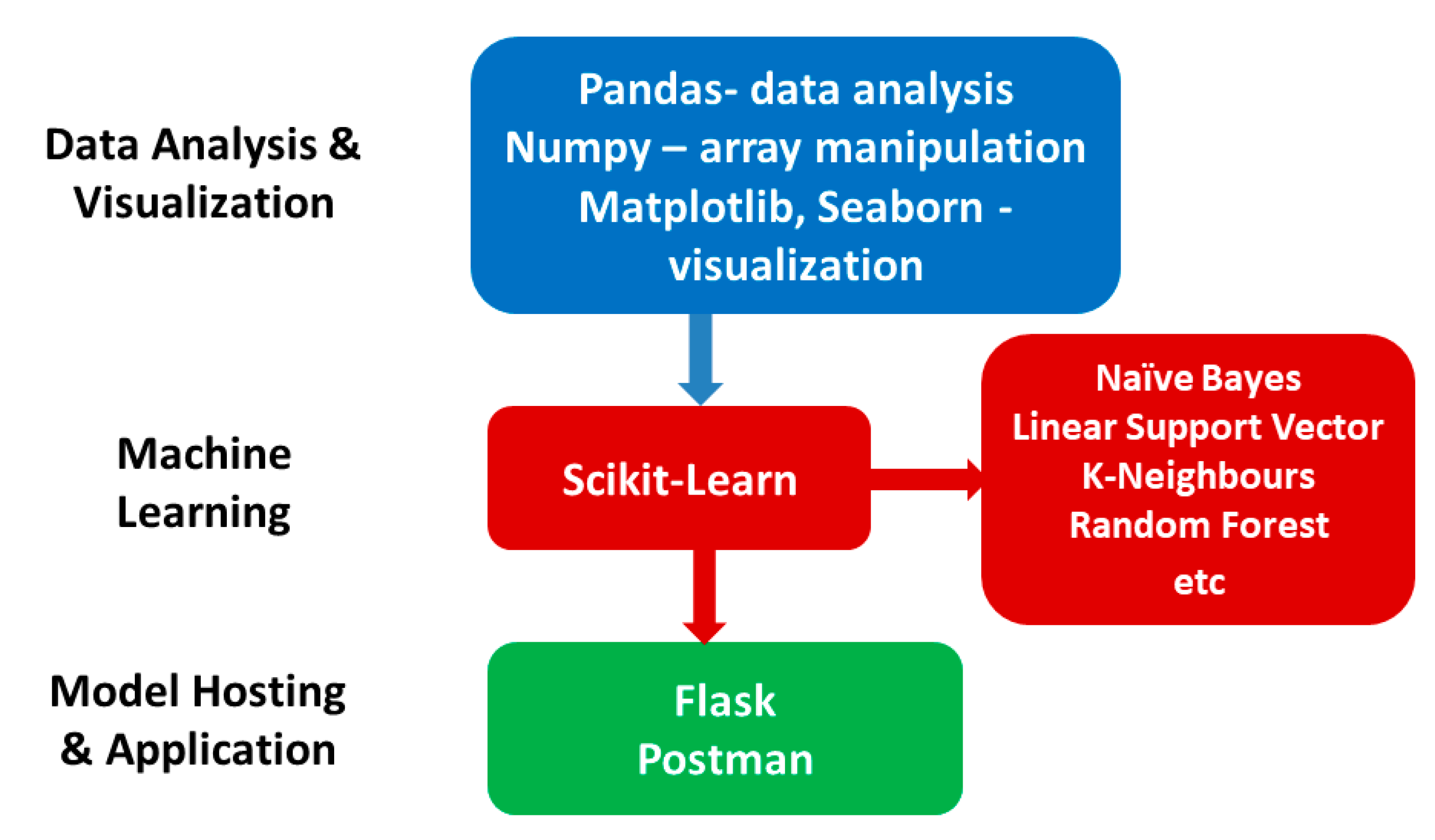


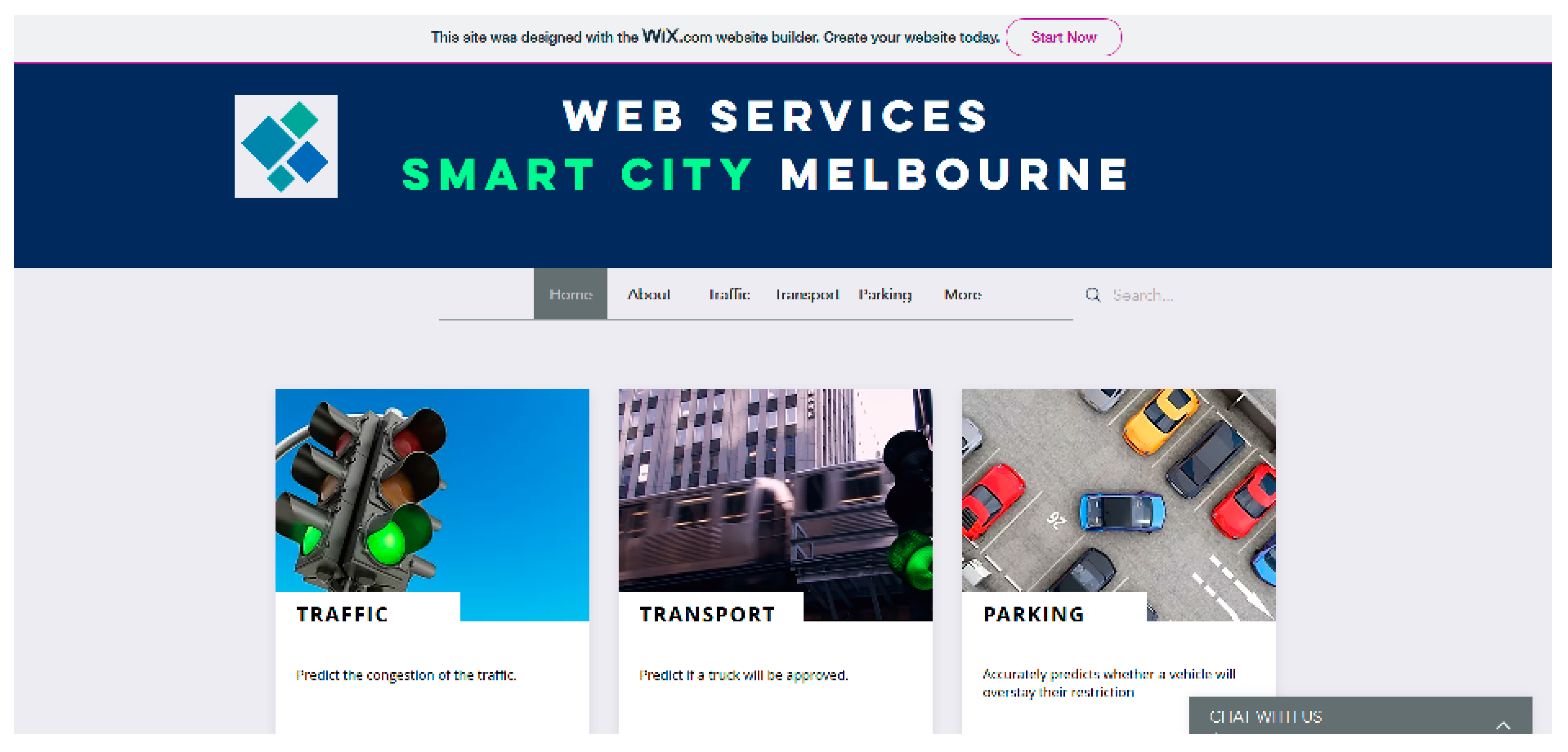



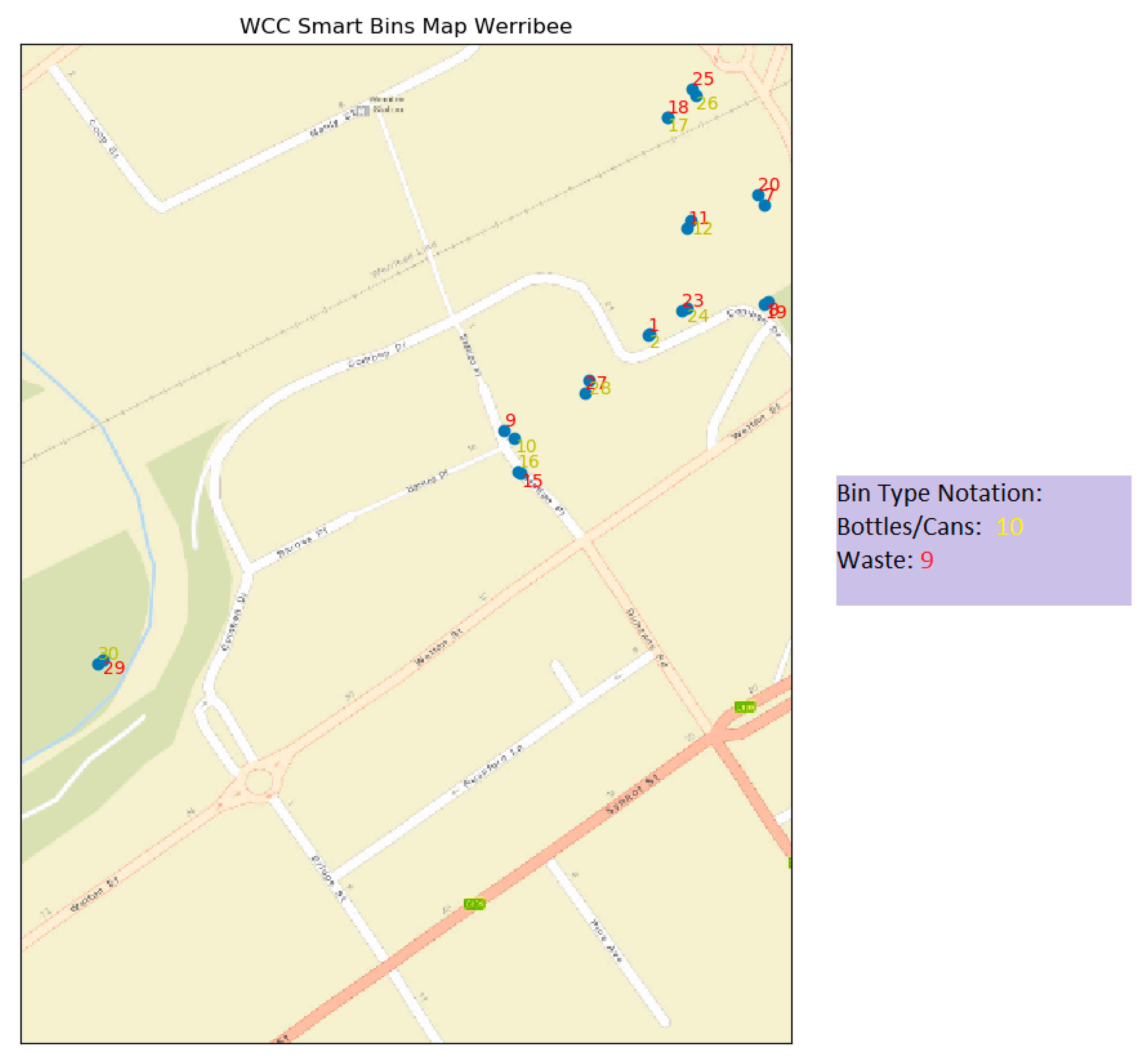


| Model | Score |
|---|---|
| Random Forest | 0.634 |
| Naïve Bayes | 0.629 |
| K-Neighbors Classifier | 0.586 |
| Linear Support Vector Classification | 0.451 |
| Feature | Importance |
|---|---|
| LIGHT_CONDITION | 0.344 |
| ROAD_GEOMETRY | 0.175 |
| SPEED_ZONE | 0.480 |
© 2020 by the authors. Licensee MDPI, Basel, Switzerland. This article is an open access article distributed under the terms and conditions of the Creative Commons Attribution (CC BY) license (http://creativecommons.org/licenses/by/4.0/).
Share and Cite
Watson, R.B.; Ryan, P.J. Big Data Analytics in Australian Local Government. Smart Cities 2020, 3, 657-675. https://doi.org/10.3390/smartcities3030034
Watson RB, Ryan PJ. Big Data Analytics in Australian Local Government. Smart Cities. 2020; 3(3):657-675. https://doi.org/10.3390/smartcities3030034
Chicago/Turabian StyleWatson, Richard B., and Peter J. Ryan. 2020. "Big Data Analytics in Australian Local Government" Smart Cities 3, no. 3: 657-675. https://doi.org/10.3390/smartcities3030034
APA StyleWatson, R. B., & Ryan, P. J. (2020). Big Data Analytics in Australian Local Government. Smart Cities, 3(3), 657-675. https://doi.org/10.3390/smartcities3030034






